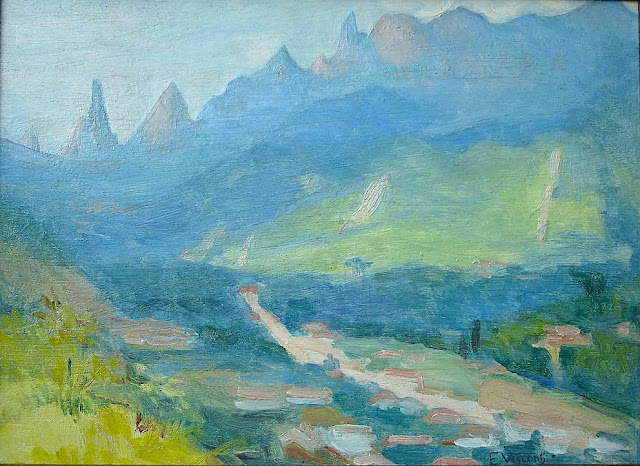Cerro Aconcagua (6962 m)
Argentine
In Aconcagua, Himalaya Andes.... Acrylique sur radiographie, 2025.
A propos des tableaux
Le peintre écrit : "
Ce n'est pas une vraie montagne. La plupart de mes peintures naissent
de la combinaison de l'imagination et des heures passées à les regarder,
à les parcourir et à les sentir. Elles ressemblent à ces reliefs de la
Cordillera andine argentine appelés "acarreos", qui sont de longues
pentes de roche meuble très populaires et facilement visibles. très
fréquemment observée. Ce tableau est donc celui d'une montagne inconnue,
rêvée qui en résume plusieurs, et qui est sortie de mon inconscient un
après-midi où le pinceau lui a donné vie de façon mystérieuse sans que
je puisse l'expliquer. " Le plus étonnant étant qu'ils le font d'un
seul coup de pinceau aussi puissant et définitif que le soulèvement
rocheux lui-même qui a crée ses reliefs.
L'artiste
Rhod Wulfars est
un peintre de montagne contemporain utilisant principalement la
technique acrylique pour ses peintures. Il est né en 1979 à Mendoza
(Argentine). Sur son site Internet, il écrit : "J'ai passé toute ma vie près des montagnes. Un jour, j'ai commencé à les peindre".
Utilisant, à la manière de Nicolas de Staël, un style toujours entre
abstrait et figuratif, ses peintures très fortes et très émouvantes
décrivent parfaitement la majesté et le contenu spectaculaire des
sommets qu'il peint. Rhod Wulfars fait un usage surprenant du médium
acrylique, en pâte épaisse comme on pourrait le faire avec de la
peinture à l'huile. Il avait l'habitude de ne nommer ses œuvres que par
des chiffres et des lettres de série, mais parfois il écrit le nom des
sommets et le rend plus facile à identifier.
Les montagnes
Les
Andes (Cordillera de los Andes en espagnol) sont la plus longue chaîne
de montagnes continentales du monde, formant un plateau continu le long
de la bordure ouest de l'Amérique du Sud. Leur étendue est de 7000 km
(4350 mi) de long, 200 à 700 km (124 à 435 mi) de large (la plus large
entre 18 ° S et 20 ° S de latitude) et d'une hauteur moyenne d'environ
4000 m (13123 pieds). Les Andes s'étendent du nord au sud à travers sept
pays d'Amérique du Sud : le Venezuela, la Colombie, l'Équateur, le
Pérou, la Bolivie, le Chili et l'Argentine.
La Cordillère des Andes
est la plus haute chaîne de montagnes en dehors de l'Asie. La plus haute
montagne en dehors de l'Asie, le mont Aconcagua en Argentine, s'élève à une altitude d'environ 6 961 m (22 838 pieds) au-dessus du niveau de la mer. Le pic du Chimborazo
dans les Andes équatoriennes est plus éloigné du centre de la Terre que
tout autre endroit à la surface de la Terre, en raison du renflement
équatorial résultant de la rotation de la Terre. Les plus hauts volcans
du monde se trouvent dans les Andes, y compris Ojos del Salado à la
frontière Chili-Argentine, qui culmine à 6 893 m (22 615 pieds).
Les
Andes font également partie de la Cordillère américaine, une chaîne de
chaînes de montagnes (cordillère) qui consiste en une séquence presque
continue de chaînes de montagnes qui forment la "colonne vertébrale"
occidentale de l'Amérique du Nord, de l'Amérique centrale, de l'Amérique
du Sud et de l'Antarctique.
________________________________________
2025 - Gravir les montagnes en peinture
Un blog de Francis Rousseau





%20Medium:%20Brush%20and%20oil%20on%20thin%20board..jpg)










